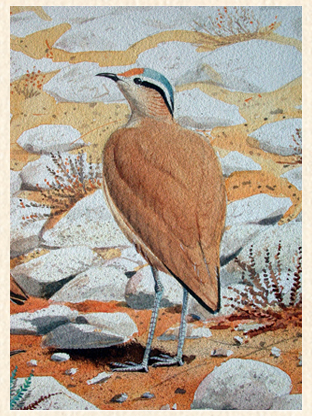
The Canary Islands belong to Spain are well-known amongst ornithologists for their endemic birds that are more or less confined to this archipelago, complemented by a few endemics which can otherwise only be found on the Azores and on Madeira to the north of the Canaries. The islands are all volcanic in origin and offer interesting and spectacular scenery; volcanos, long lava fields, laurel forest and craggy coasts. We will explore three of the seven islands of the archipelago, these three islands hold all the endemic species, a great number of endemic sub-species as well as good numbers of seabirds and desert species that also can be found in North Africa.
Fuerteventura is the most arid of the three islands with rolling plains, sand dunes and desert habitats, This island is unique for the Canary Island Chat, other interesting species include the Egyptian Vulture, Barbary Partridge, Cream-coloured Courser, Lesser Short-toed Lark, Spectacled Warbler, Common Raven, Southern Grey Shrike and Trumpeter Finch.
La Gomera, a small island where the original laurel forest remains well conserved is also more than worth a day trip. The ferry trip itself is a good experience, with Petrels and Shearwaters often in evidence along with Dolphins and Pilot Whales. La Gomera boasts large populations of the two laurel pigeons, plus the Kinglet and local race of the Sparrowhawk.
Tenerife : This island holds the highest mountain peak in Spain - Teide at 3.700 mts. This island is the best one for the few watering bird species unique to the islands, the two endemic laurel pigeons, Bolle`s Pigeon and Laurel Pigeon and the Tenerife Kinglet. Also interesting is the Blue Chaffinch as well as the distinctive local race of the Great Spotted Woodpecker.
Day 1.- Meet you at Tenerife South airport and drive to the hotel. After Check in we will explore the surroundings of Presa Curbelo where Berthelot's Pipit and Plain Swift are commom. Other interesting species are the local races of Southern Grey Shrike, Common Kestrel and Spectacled Warbler. Overnight in the exquisite hotel at Guimar village.
Days 2,3.- We will drive up to the pine forests bellow Teide mountain. In these forests, we will see the endemic Blue Chaffinch, the Tenerife Blue Tit, also a genuine wild Canary. Other interesting species present include the endemic sub-species of Great Spotted Woodpecker, Eurasian Kestrel and Rock Dove. Four of the endemics, Canary Islands Kinglet, Plain Swift, Berthelot's Pipit and Common Canary, are quite common in the pinewoods and surrounding area. Drive to the foothills of the Teide were the volcanic landsacapes around Teide peak are a polichromatic texture of sand, stones and semi-desert vegetation which gives to the area an special atmosphere. Despite its reputation as a mass holiday destination and its associated development, Tenerife Island holds important masses of laurel forest where we will look for the two endemic pigeons, Bolle's and Laurel where we will also see Canary Island Chiffchaff and the local Kinglet, a graceful noisy creature - cross between a Goldcrest and a Firecrest. Overnight at Guimar Village.
Days 4, 5.- Drive to Tenerife north to take a morning flight to Fuerteventura. This unique island, where we´ll see the endemic Canary Islands Chat, is rich in good birding areas. We will visit several of them; Barranco del Rio Cabras, Barraco de la Torre and Finca de Jarde (recently acquired by SEO-Birdlife to protect its interesting steppe bird life) where we will find interesting species such as Black-bellied Sandgrouse, Houbara Bustard, Stone Curlew, Cream-coloured Courser and Lesser Short-toed Lark. We may also visit the reservoir at Los Molinos to look for waterbirds and Tindaya where we will find Common Buzzard, Eurasian Kestrel, Sardinian and Spectacled Warblers. Overnight in the area of Costa Calma.
Day 6.- In the morning we will go to La Palya de los Gigantes for a possible pelagic trip were Pilot, Short-finned Whale and Common Doplhin are our tagets, also good chances for Osprey and Cory´s Shearwater. We will head to the north-western side of Tenerife to another excellent site of laurel forest for Bolle's Pigeon and Canary Islands Kinglet. We will also visit the Anaga Peninsula where we´ll look for European Serin, Canary Islands Chiffchaff and the endemic sub-species of Common Chaffinch and European Robin. This is also a good area for Barbary Falcon. Drive to our Hotel at Guimar village.
Day 7.- The ferry crossing from Tenerife to La Gomera offers us the opportunity to observe several seabirds - petrel, skua and shearwater as well as cetaceans. On the return journey to Tenerife, we will have another chance to look for seabirds. Today we will explore the island of Gomera and the Garajonay National Park; a small but attractive laurel forest surrounded by geological formations named “puntas” where the endemic Bolle's and Laurel Pigeons occur, other specie is the Canary Islands race of Common Buzzard. We will walk along a river in the heart of the Grajonay National Park where the prehistoric ambience is magnified by the dense laurel forest, the silence only being broken by the song of Canary Chiffchaff and Blue Tit. At the end of the walk in a ruined house we will find the interesting endemic lizard “Gallotia caesaris”. Overnight in Guimar village.
Day 8.- In the morning, we will visit Punta de Rasca for our last look at seabirds. This area is good for Berthelot's Pipit, Trumpeter Finch, Lesser Short-toed Lark, Barbary Partridge and the local race of Lesser Short-toed Lark. Later in the day we transfer to the airport for our flight home.